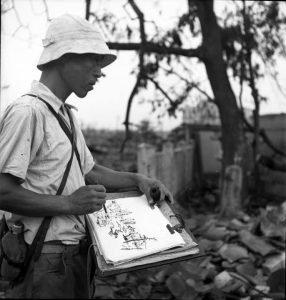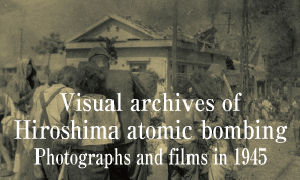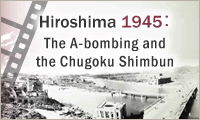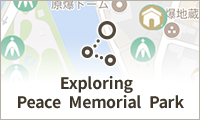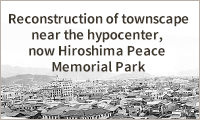Documenting Hiroshima of 1945: September 9–10, local painter uses paintbrush to make record of ruined city
Sep. 10, 2024
by Kyosuke Mizukawa, Senior Staff Writer
On September 9, 1945, Keiso Takamasu, a Japanese-style painter with the actual first name of “Keizo” who died in 1985 at the age of 84, worked to depict the central area of Hiroshima City with his paintbrush. Using ink and oil pastels, he created images of the city turned to ruins by the U.S. military’s atomic bombing, including the scorched earth covered in debris as well as buildings and trees left standing after the fires that had arisen after the bombing.
At the time, Mr. Takamasu worked as a fine arts instructor at the Prefectural School for the Deaf (present-day Hiroshima Minami Special Needs School, in the city’s Naka Ward). On August 14, he first entered the city from the northern part of Hiroshima Prefecture, where he had evacuated, to check on the situation of his school and home. He returned to the city area once more with the aim of “keeping a permanent record of the tragic situation.”
Mr. Takamasu had lost his hearing in childhood. He was able to read lips and could communicate with his voice, but he was accompanied on his journey into the city on this day by his oldest son, Fumio, nine years old at the time, as he had been on the previous trip in August, to ensure better communication with others.
Fumio described what he experienced on September 9 in his journal. “My father drew an image of Hiroshima Station. As he was drawing more images of all directions in the area, a journalist for a U.S. newspaper came over, took three photographs of him, saluted in an American way, and went off in another direction,” he wrote.
The journalist who took the photos of the painter was the late Wayne Miller, who had worked as a war correspondent photographer for the U.S. Navy. Mr. Miller photographed Mr. Takamasu as he was drawing the Hatchobori area in Hiroshima’s downtown.
Mr. Takamasu drew more images in the city on September 10. The Hiroshima Peace Memorial Museum has 21 of his A-bomb drawings, which were donated by surviving members of his family, as well as the journal of his son, Fumio, who died in 2015. Tetsuya Takamasu, 60, Mr. Takamasu’s grandson and the oldest son of Fumio who is now a resident of Yokohama City in Kanagawa Prefecture, said, “Conflicts between humans must never cause the tragic conditions depicted in my grandfather’s drawings.”
During that same period, the Manhattan District Survey team, led by Brigadier General Thomas Farrell, second-in-command of the U.S. project established to develop an atomic bomb, was also in Hiroshima. On September 9 and 10th, the survey team examined survivors who had been admitted to the Army Hospital and other medical facilities.
(Originally published on September 10, 2024)
On September 9, 1945, Keiso Takamasu, a Japanese-style painter with the actual first name of “Keizo” who died in 1985 at the age of 84, worked to depict the central area of Hiroshima City with his paintbrush. Using ink and oil pastels, he created images of the city turned to ruins by the U.S. military’s atomic bombing, including the scorched earth covered in debris as well as buildings and trees left standing after the fires that had arisen after the bombing.
At the time, Mr. Takamasu worked as a fine arts instructor at the Prefectural School for the Deaf (present-day Hiroshima Minami Special Needs School, in the city’s Naka Ward). On August 14, he first entered the city from the northern part of Hiroshima Prefecture, where he had evacuated, to check on the situation of his school and home. He returned to the city area once more with the aim of “keeping a permanent record of the tragic situation.”
Mr. Takamasu had lost his hearing in childhood. He was able to read lips and could communicate with his voice, but he was accompanied on his journey into the city on this day by his oldest son, Fumio, nine years old at the time, as he had been on the previous trip in August, to ensure better communication with others.
Fumio described what he experienced on September 9 in his journal. “My father drew an image of Hiroshima Station. As he was drawing more images of all directions in the area, a journalist for a U.S. newspaper came over, took three photographs of him, saluted in an American way, and went off in another direction,” he wrote.
The journalist who took the photos of the painter was the late Wayne Miller, who had worked as a war correspondent photographer for the U.S. Navy. Mr. Miller photographed Mr. Takamasu as he was drawing the Hatchobori area in Hiroshima’s downtown.
Mr. Takamasu drew more images in the city on September 10. The Hiroshima Peace Memorial Museum has 21 of his A-bomb drawings, which were donated by surviving members of his family, as well as the journal of his son, Fumio, who died in 2015. Tetsuya Takamasu, 60, Mr. Takamasu’s grandson and the oldest son of Fumio who is now a resident of Yokohama City in Kanagawa Prefecture, said, “Conflicts between humans must never cause the tragic conditions depicted in my grandfather’s drawings.”
During that same period, the Manhattan District Survey team, led by Brigadier General Thomas Farrell, second-in-command of the U.S. project established to develop an atomic bomb, was also in Hiroshima. On September 9 and 10th, the survey team examined survivors who had been admitted to the Army Hospital and other medical facilities.
(Originally published on September 10, 2024)



